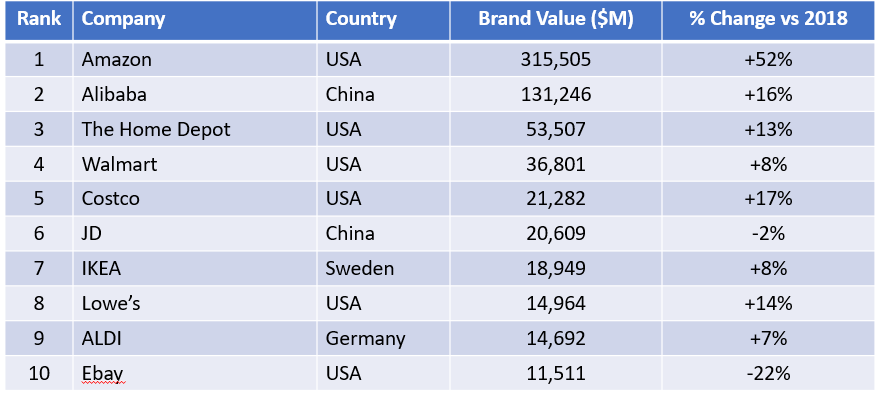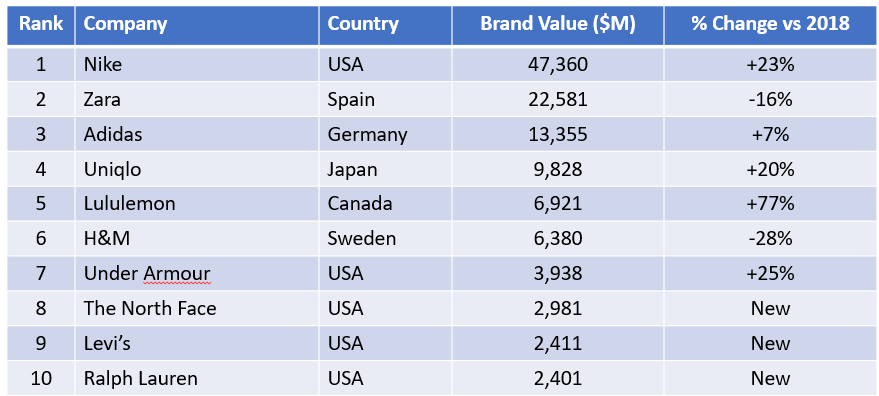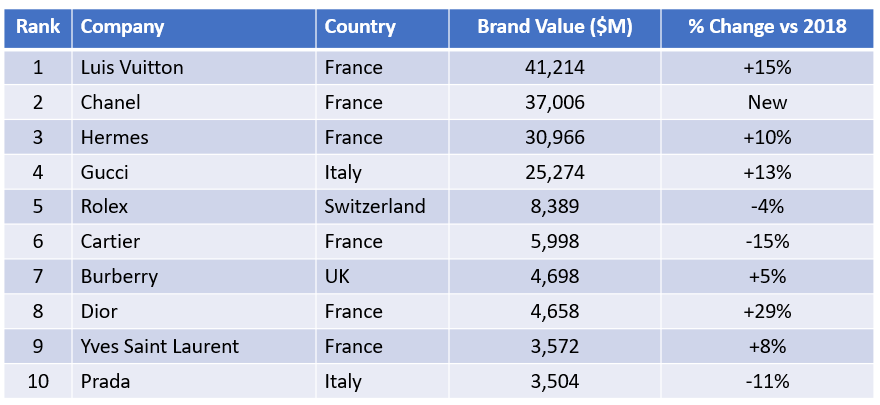In today's increasingly complex world, branding is critical to lasting success. Every year, I look forward to the latest BrandZ Top 100 Most Valuable Brands study. This article summarizes the nearly 200 pages report with a focus on retail, apparel, luxury, and technology brands.
"In a year marked by rising consumer expectations, the erosion of category boundaries, and geopolitical disruptions, the 2019 BrandZ™ Top 100 Most Valuable Global Brands increased 7% in value. This hard-won gain outperformed the global GDP growth rate and added $328 billion to the BrandZ™ Top 100, bringing its total value to $4.7 trillion."
"Consumers expected superior customer experience, including rapid delivery. More mindful about the health and wellness of themselves and the planet, they also demanded a high level of responsibility and ethical behavior from brands. To meet consumer expectations, brands become more sophisticated about gathering and analyzing data, increasingly applying the insights across multiple businesses and ignoring category borders to create integrated brand ecosystems."
"Data-driven improvements in customer experience and personalization helped drive the value growth of the three fastest rising categories: luxury, up 29%; retail, up 25%, and insurance, up 15%."
The Top 10 Retail Brands - Digitization Transforms Shopping Experience
"It was not a surprise, but it was not inevitable. Amazon this year surpassed Apple and Google to reach the No. 1 rank in the BrandZ™ Top 100 Most Valuable Global Brands. With a 52 percent year-on-year increase, Amazon achieved a brand value of $315.5 billion."
"To meet — and shape — consumer expectations for frictionless shopping, retailers rebalanced and integrated their online and offline operations. Walmart, with a legacy of physical stores, invested in improving online presence, and e-commerce leaders Amazon and Alibaba added physical locations."
Retail was one of the fastest growing brand value categories at +25%. Over the last 13 years of the report, retailers' brand value has increased 378% and the top 20 are valued at $721 billion.

The BrandZ brand building action points for retail include:
- Have a Purpose
- Leverage the Physical Store
- Be Reachable and Relevant
- Remove All Friction
- Make Some Bets
- Be Present at the Moment of Truth
The Top 10 Apparel Brands - Consumers Seek Style, Comfort, & Purpose
"Getting people to buy more apparel was a difficult sell in a year when books about decluttering were among the best sellers. Brands that succeeded not only got fashion right, they aligned with changing consumer values about sustainability and offered functionality that met health and wellness priorities. On the strength of athleisure brands, the apparel category rose 6%, compared with 5% a year ago."

The BrandZ brand building action points for apparel include:
- Be Inclusive
- Be Responsible
- Be Distinctive
- Be Versatile
- Be on the Trend
- Tailor the Experience
- Explore Other Business Models
- Help People Improve
The Top 10 Luxury Brands - More Accessible, Remaining Aspirational
"Although the number of people able to purchase luxury products remained limited, social media expanded the opportunity for more people to appreciate luxury brands. Becoming more accessible in attitude, if not price, luxury topped all categories in brand value appreciation in the 2019 BrandZ™ Global Top 100, rising 29%, after a 28% rise a year ago."
"With the use of technology, the brands democratized customer centricity. In the past, customer centricity meant being in the rolodex of a salesperson in a favorite store. Today, customer centricity means being in a database that indicates the preferred style, size, and method of delivery, even to the office in discrete packaging."

The BrandZ brand building action points for luxury include:
- Be Accessible, but Exclusive
- Be in the Right Channels
- Extend the Luxury Experience
- Expand Online Shopping
Branding and Future Success
"Brands are operating in an increasingly volatile and complex environment. The development of brand ecosystems and the blurring of categories—even the distinction between products for business or personal use—is stressing value growth and the organization of brands by category, as many brands no longer fit into only one, narrowly-defined space."
Actions to cultivate disruptive thinking:
- Place Innovation at the Top of the Table - "Too many brands underfund and isolate the people responsible for disruptive thinking. Even the lingua franca of skunkworks, labs and far out innovation create a perception that this is not business critical. This is dangerous. Ensure adequate resources and C-suite engagement, to drive systemic change that has business impact."
- Broaden Your Frame of Reference - "What category are you really competing in? Casper is not a mattress producer, it’s a sleep lifestyle brand. Halo Top doesn’t sell ice cream, it’s a purveyor of delicious healthy treats. How would this expanded worldview change how you might think about innovation?"
- Imagine a World where Your Brand does not Exist - "What happened? Why did it die? What existential threats are already out there, be it regulatory control, competitive threat or consumer behavior? Doomsday scenario planning may seem far-fetched, but it encourages a way of thinking that will foster genuine Disruption, not short term incrementality."
This is indeed the branding age to disrupt or be disrupted.
from Blog - Tony D'Onofrio https://ift.tt/2NrqnQD
via IFTTT
Comments
Post a Comment